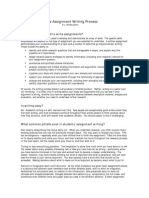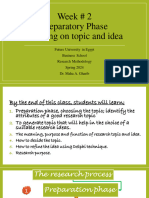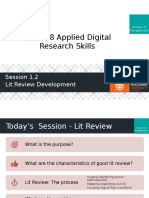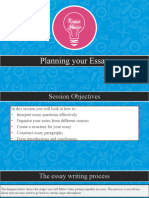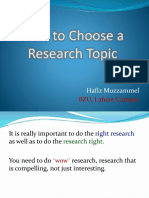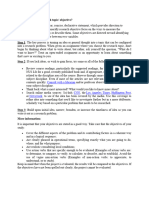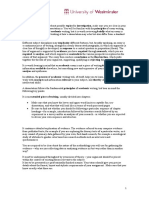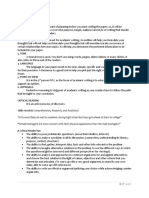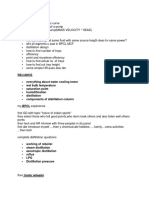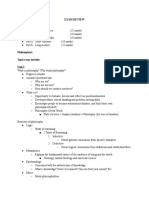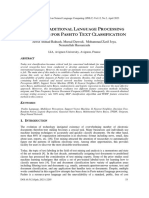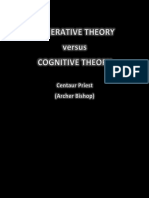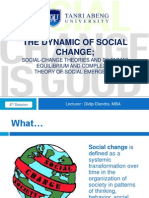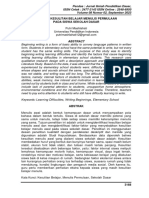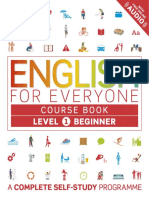Academic Writing Template
Academic Writing Template
Uploaded by
jeswin354Copyright:
Available Formats
Academic Writing Template
Academic Writing Template
Uploaded by
jeswin354Original Description:
Copyright
Available Formats
Share this document
Did you find this document useful?
Is this content inappropriate?
Copyright:
Available Formats
Academic Writing Template
Academic Writing Template
Uploaded by
jeswin354Copyright:
Available Formats
ACADEMIC WRITING TEMPLATE
Work through this proforma step by step to develop your essay or report
STEP 1 Analysing the question
You cant answer a question if you do not understand all of its
terms.
Here you are clarifying the task. Gain a better understanding of
Reading carefully ensures that you answer the question.
what the question is asking.
A good interpretation helps you plan your answer.
At all points, consider how the topic fits into your unit.
It is important for you to realise that each question requires
some kind of analysis and interpretation, in order to determine
an appropriate way of responding to it.
Action Record
Write out the whole question, topic thesis..
If you do not have a question write a sentence to
explain what it is you need to do for the writing task.
Record defining words (the overall topic) , key words
or concepts eg social class, creative industries,
oligarchy, heroic tradition, pain management, imperial
power
Record directive words (what you have to do with the
topic (the task) these words often give you a clue to the
structure the essay should follow, e.g. if directive word is
compare then you present a comparison in your writing).
- words that give direction for approaching the essay
e.g. discuss, evaluate, compare, analyse, find causes,
contrast, investigate, categorise, identify, interpret,
describe, illustrate, differentiate, explain, criticise,
summarise, justify..
Record limiting words (set some scope or narrow the
area of focus)
words that limit your topic e.g. in the past 5 years, in
children, 2 theories
Record content words (these refine an aspect of the
task or directive word)
Restate your question, topic, thesis here in your own
words.
The advantage of doing this is that you should now be very
clear about what it is you need to write about. If you cannot
explain this satisfactorily in your own words, seek some clarity
from your lecturer/tutor.
Say/Ask: I am not sure what this question is asking me to do.
Academic Writing Template 1
STEP 2 Brainstorm
Brainstorming and concept mapping are strategies used Here you consider:
to gather your thoughts from your existing knowledge of What do I know?
a topic. This information may come from readings, What do I need to find out?
lectures and tutorials.
Action Response
1.Give yourself a time limit
2.Remember that this is only the
beginning of your thinking, you will need to
Develop either a list OR a concept map of your thinking
add on to this list/map as your
understanding of the topic expands.
3. Ask: who, what, when, where, why, how
(5W + 1H)
Draw a Concept Map to record your thinking
Content words
Main theme or topic
Academic Writing Template 2
STEP 3 Develop Focus Questions To lead your research
Ask what do I need to know?
Example questions
Content?
Who is affected by this?
Academic literature?
Where is the (problem)?
Refer to your concept map
When (at what point) are .?
Why is this (issue) important?
Check you are on topic
How can this be addressed?
Do I need to know about?
Check unit objectives, assessment guidelines and marking criteria
What are the points of view of others?
Action Record
Based on what you have realised in your brainstorm
ask What, Why and How?
What do I need to know more about?
What research has been undertaken?
What topics/ theories have been covered?
Who is the writer/researcher?
Who has said what about this topic?
Eg Smith theory of.
What can I find to support my thinking?
Who agrees with my ideas/ opinions / thesis
Remember
Well-focused questions are precise.
Well-focused questions ask for useful information.
Well-focused questions can be answered with
meaningful information.
Well-focused questions encourage inquiry and
research.
And of course, well-focused questions have to be
questions (not statements).
Academic Writing Template 3
STEP 4 Browse the Literature
Gather information that responds to your FOCUS
QUESTIONS. Remember to use your Unit readings, CMD and texts as
Ask a librarian for assistance with database searches if a starting point.
necessary.
Action
Go to the source for your information.
With your focus questions in mind:
look for key words/concepts
carry out combined searches
refer to general texts, specialized texts (relating to your field), journals, government publications and newspapers
No notes at this stage SKIM read no deep reading at this point
Think about the types of material you will be using:
Record those references that have potential Factual information; ideas, hypothesis; theories;
opinions; evidence; experience
So that you do not need to constantly update information for your final reference list, record it here as you go.
Title Author / Editor Year Publication Main Points (relevant to
Type topic)
1.
2.
3.
4.
5.
6.
7.
8.
9.
10.
11.
You can add more as required
Academic Writing Template 4
STEP 5 Analyse the Literature
Does the literature match your information requirements?
New information may change your ideas about what you thought you needed.
You may need information and sources you did not expect or you may have too much information.
Action
Use critical thinking strategies to evaluate sources. Ask the 5W & 1 H
Select sources according to their relationship to your focus questions
Photocopy or borrow publications Read in depth
Selectively underline or note key words, phrases or Use focus questions as headings
ideas
Determine the worthiness of the source of information.
Unless you can be sure that the information you are using is reliable, you should focus on using resources located from the
Library i.e. texts, journal articles from scholarly publications.
Using your Unit Outline and 2. Authenticity: What are the 4. Coverage : Is adequate
Marking Criteria evaluate the author(s) credentials? Was the detail provided? Is the
Sources and identify those most information published in a information too basic, too
useful and appropriate for your recognised (or peer- complex or relevant?
purposes reviewed/refereed) journal? 5. Currency : Was the item
published recently? Is the
Five points to consider when 3. Bias : Are the arguments data current? Was the web
evaluating a resource: presented fairly? Does the author page updated recently?
have an ulterior motive or are they
1.Accuracy : Can you expressing an opinion?
verify the factual information
provided? Is methodology stated?
Focus Question Reference Brief Notes
Academic Writing Template 5
STEP 6 Map the Structure
Identifying and developing clear structure before you start to write is vital for two reasons.
It enables;
1. you as the writer to keep track of your thoughts and present your ideas logically and coherently without
getting off the track and;
2. the person marking your work to follow your argument more easily.
Look at directive words for clue to structure, e.g compare, discuss etc
Planning your structure: Comparison
Some common structure formats Problem/solution
Cause/effect
List/sequence
Action
a) Decide on headings even though you may not use the heading in your final presentation
b) Decide on major topics/ themes (check back at your question analysis and brainstorm)
c) Identify what reference you WILL use (discard others)
d) Identify issues you need to follow up on eg clarify the expectations with your lecturer/tutor
(last chance before you start writing)
Academic Writing Template 6
Structure formats
Description structure
Introduction
Body
Main idea 1 Supporting detail A
B
C
Main idea 2 Supporting detail A
B
C
Main idea 3 Supporting detail A
B
C
Conclusion
Academic Writing Template 7
Comparison structure (tight)
Introduction
Body
Features to be Theory 1 Theory 2
compared
A
Conclusion
Cause/Effect Structure
Introduction
Cause Effect 1
Effect 2
Effect 3
Conclusion
Problem/Solution Structure
Introduction
Academic Writing Template 8
Body
Outline of problem
Present and discuss/compare solutions
Conclusion
Approximate allocation of words for introductions and conclusions
Approximate introduction/conclusion allocation
Number of words in assignment
(combined)
1000 total word count 200
2000 total word count 300
3000 total word count 500
% of Total word count
Introduction 10% of word count
Body 80% of word count
Conclusion 10% or word count
Academic Writing Template 9
The Introduction
Focus attention
Focus on topic/clarify the topic
Define key words/concepts if
necessary
Provide an overview of the paper
Explain the purpose of the paper
Briefly outline the issues/theme
Restate the problem/question
1 or 2 paragraphs?
The Body
Topic sentence
Support with detail, examples,
references
Use a thread or through line (get the
flow happening)
- Link sentences
- Link paragraphs
- Link forwards
- Link backwards
Use signal words/signposts for the
reader
Pick up (repeat) words
Use pronouns
The Conclusion
General comments relevant to the
topic
No new information to be
introduced
Answer question/issues raised
Pick up threads and synthesise
Leave reader with a thought
yours
Way forward?
Future research?
Academic Writing Template 10
STEP 7 Write a draft and Incubate
Start at the body & number the issues then conclusions and introductions
Easier to summarise and conclude once you have the body clearly structured.
Work out the order to introduce your ideas, using your Write your draft quickly it is only a draft. Write under
notes/headings and points each heading (you can remove it from your final draft
but it helps you focus as your write.
Dont worry about style, spelling, grammar or Follow your concept map
references.
Relate all writing to the marking criteria consider the unit objectives
Allow your draft time to sit. Give yourself a break Ban perfectionism!
from the task (at least 24 hours) before your return to it
for the final step
Topic Sentence introduces key idea
Every paragraph requires a topic sentence to assert and control its main idea. Without a
topic sentence, your paragraphs will seem jumbled and your reader will be confused.
- Does the topic sentence declare a single point of my
argument?
- Does the topic sentence further my argument? (Ask
so what).
- Is the topic sentence relevant to my thesis? (it may be clear to you but what about your
reader).
- Is there a clear relationship between this topic sentence and the paragraph that came
Second and/or final before? (use transitional phrases - on the other hand, however, etc. to signify the change in
draft reasoning).
Check that you have - Where have I placed my topic sentence? (Mostly at the beginning of a paragraph. You
written effective might justify the topic sentence in the middle of the paragraph, for example, if you have
paragraphs information that needs to precede it. It could also go at the end of the paragraph, if you
want the reader to consider your line of reasoning before you declare your main point).
Subsequent sentences Supporting sentences present the relevant details that elaborate
the point of the topic sentence. They often give you 'how', 'why' and 'what' examples that
relate to the topic sentence. These examples will support or offer proof of the main idea
within the topic sentence. Each sentence adds relevant information to the topic sentence to
enable the point to be established clearly in the reader's mind.
Concluding sentence A concluding sentence rounds off or concludes the paragraph.
In many instances, the concluding sentence may also provide a bridge or pointer to the content of the
next paragraph. The concluding sentence rounds off the paragraph by drawing attention back to the
topic sentence as well as setting the scene for a shift to the next point.
STEP 8 Edit, Proofread, copy and Hand in!
Action
Read for meaning Read aloud
Read for typos and spelling errors Correct
Read for grammar and punctuation errors Copy (paper, email to your ECU WebMail, save to
hard drive, save to disk)
Read backwards (helps identify words out of place) Hand in on time
Academic Writing Template 11
Editing Checklist
Have I answered the question or task as fully as Have I fully referenced my sources of information?
possible? Have I referenced all the words, ideas and
What is my thesis/ central proposition/ main information sources I have used in my
assertion? assignment?
Do I make a clear argument or take a Have I used a consistent referencing style?
position about the topic? Do I state that Is there a clear distinction between my
position in my introduction? thoughts and words and those of the author(s)
Does my introduction or opening paragraph I've read and cited?
prepare the reader for what follows? Are quotations properly introduced?
Is my essay clearly structured? Are they accurate?
Does my assignment have a clear Are they formatted correctly?
introduction, a body and a definite
Do the quotations add evidence or provide an
conclusion?
authoritative voice, or am I letting the author(s)
Does the assignment advance in logical speak for me? Would writing it in my own
stages? words be more effective?
Are the major points connected? Are the Have I remained within or exceeded the set word limit?
relationships between them expressed I don't have enough words:
clearly? Have I fully answered the question or task?
Do the major points all relate to the topic Do I need to read more? Should I include more
and contribute to answering the task or information or discussion?
question?
Are my paragraphs clearly connected and coherent?
Have I provided enough evidence to support
my argument/s?
Does each paragraph begin with a topic I have too many words:
sentence?
Have I included only relevant information?
Do the sentences flow smoothly and
logically from point to point?
Is there any unnecessary repetition in my
assignment?
Does each sentence clearly follow on from
the one before?
Is my written expression as clear and concise
as possible, or is it too 'wordy'?
Does each paragraph state its case clearly Have I proof read and revised my assignment for
and completely, or should there be more errors?
evidence/ detail?
Have I checked my spelling? Have I read
Are there adequate transitions between through my assignment and not just relied on a
sentences and paragraphs? Are transitions computer spell checker?
varied or are they all the same kind?
Is all my bibliographical information correct?
Are all examples and quotes relevant to
and supportive of my answer?
Have I used correct punctuation? Have I
ended every sentence with a full stop?
Are facts and opinions supported with Is my assignment well presented?
examples or explanations where
Does the presentation follow any guidelines
necessary?
set by my lecturer or school?
Is my written expression appropriate?
Have I used direct and clear language? Have I included a cover sheet? (assignment
cover sheets are available from your school
Have I explained my ideas clearly and office)
explicitly?
Have I made sure my assignment is legible? Is
Have I kept my audience in mind? Have I it typed or written neatly?
said all I need to say so that my reader can
understand, or am I assuming they will
Have I used double-line spacing?
'know what I mean'? Have I numbered pages and used wide
Have I written complete, grammatically margins?
correct sentences? Have I kept an extra copy?
In long sentences, have I separated related
ideas with commas or semicolons for http://www.lc.unsw.edu.au/onlib/edit.html
easier understanding? Accessed: 290306
Is my use of tenses correct?
Have I used non-discriminatory language?
Academic Writing Template 12
Academic Writing Template 13
You might also like
- Elder Paul (2010) Critical Thinking DevelopmentDocument5 pagesElder Paul (2010) Critical Thinking DevelopmentmobzoneNo ratings yet
- Overcoming Shyness PDFDocument38 pagesOvercoming Shyness PDFChizzy David .ONo ratings yet
- Academic Writing TemplateDocument13 pagesAcademic Writing Templatejeswin354No ratings yet
- HHG4M Unit 1 WorkbookDocument13 pagesHHG4M Unit 1 WorkbookJojoNo ratings yet
- Report Writing GuideDocument4 pagesReport Writing GuideTiffany LynchNo ratings yet
- CRWT Week 4Document23 pagesCRWT Week 4Honey marquezNo ratings yet
- Researchunitsyllabus 1Document6 pagesResearchunitsyllabus 1api-295113878No ratings yet
- The Assignment Writing Process: Why Are You Expected To Write Assignments?Document4 pagesThe Assignment Writing Process: Why Are You Expected To Write Assignments?Chepuru Venkata SivaNo ratings yet
- Chapter 2 - Corporate ResearchDocument41 pagesChapter 2 - Corporate ResearchAngelo Euraux PejiNo ratings yet
- EPQ Guidance Booklet CompressedDocument12 pagesEPQ Guidance Booklet CompressedRamesh SharmaNo ratings yet
- 4a Self Revision SlidesDocument10 pages4a Self Revision SlidesAtômica JeansNo ratings yet
- S2 Lecture 5 Reading SkillsDocument40 pagesS2 Lecture 5 Reading SkillsMai Trần Phước Linh (FGW DN)No ratings yet
- Phase I Research Organization Document 2022Document2 pagesPhase I Research Organization Document 2022api-632827798No ratings yet
- Doing A Reading ReflectionDocument1 pageDoing A Reading ReflectionHanlie HaroldtNo ratings yet
- Unit 1 Reading SkillsDocument14 pagesUnit 1 Reading SkillsTessna SadikiNo ratings yet
- Week 4 - Steps in Critical Reading-1Document8 pagesWeek 4 - Steps in Critical Reading-1JULIE ANN ABAYONNo ratings yet
- Advanced Academic Writing: Week 4 10/26 (Wed)Document47 pagesAdvanced Academic Writing: Week 4 10/26 (Wed)sun-shuting2022No ratings yet
- 308 Advance Research MethodologyDocument27 pages308 Advance Research MethodologyGolam RaufuNo ratings yet
- 7 Steps To Essay Writing - Cill EditDocument10 pages7 Steps To Essay Writing - Cill EditLyra :]No ratings yet
- Formulating Your Research QuestionDocument3 pagesFormulating Your Research QuestionCedric Kurt TagubaNo ratings yet
- Doc-20240419-Wa0006 240419 170620Document20 pagesDoc-20240419-Wa0006 240419 170620shi88y1No ratings yet
- CRWT Week 4Document23 pagesCRWT Week 4Marianne Jade HonorarioNo ratings yet
- Practical Research 2 Chapter 2Document56 pagesPractical Research 2 Chapter 2Edward StewardNo ratings yet
- Dissertation Handbook RKC 2022Document34 pagesDissertation Handbook RKC 2022Fiaz Ahmed LoneNo ratings yet
- DRS 20 - 21 - W1 - L2 - TaggedDocument25 pagesDRS 20 - 21 - W1 - L2 - TaggedMahreen MalikNo ratings yet
- Structuring Your Essay BookletDocument24 pagesStructuring Your Essay BookletSuporn BylpNo ratings yet
- Research Process LastDocument9 pagesResearch Process LastkrrishgoenkaNo ratings yet
- FROM: Preparing A Manuscript For Publication: A User-Friendly Guide (PMC2528624) Step 1: Finding The Time To ThinkDocument3 pagesFROM: Preparing A Manuscript For Publication: A User-Friendly Guide (PMC2528624) Step 1: Finding The Time To ThinkemilioNo ratings yet
- PG Study Smart Writing Postgraduate Coursework AssignmentsDocument31 pagesPG Study Smart Writing Postgraduate Coursework AssignmentsAlvin230No ratings yet
- Staff - Shares - Storage 500mb - Library - ID112668 - Rwanda - HowToWriteAPhDProposalDocument4 pagesStaff - Shares - Storage 500mb - Library - ID112668 - Rwanda - HowToWriteAPhDProposalnoraNo ratings yet
- Eap 2 U1 PDFDocument14 pagesEap 2 U1 PDFPial Hassan ChowdhuryNo ratings yet
- Steps in Literature ReviewDocument8 pagesSteps in Literature Reviewcuutpmvkg100% (1)
- Analyzing Qualitative DataDocument33 pagesAnalyzing Qualitative DataanickalakibulNo ratings yet
- A Little Guide To Researching Your AssignmentsDocument12 pagesA Little Guide To Researching Your AssignmentsPopescu Viorica100% (2)
- 1 - First Lecture Literature ReviewDocument19 pages1 - First Lecture Literature Reviewahmed mohamedNo ratings yet
- Choosing A Research Topic & Writing A Research TitleDocument7 pagesChoosing A Research Topic & Writing A Research TitleJester Guballa de LeonNo ratings yet
- Literature Review Step by Step Guide For StudentsDocument7 pagesLiterature Review Step by Step Guide For Studentsc5qzgez0100% (1)
- Research Problem Significance Scope DelimitationsDocument23 pagesResearch Problem Significance Scope DelimitationsAndreiNo ratings yet
- Planning Your Essay NewDocument27 pagesPlanning Your Essay NewDrishna ChandarNo ratings yet
- 22J RQ and Ethics Tutorial OnlineDocument49 pages22J RQ and Ethics Tutorial Onlinemorseclose22No ratings yet
- Parts of A Reserach PaperDocument7 pagesParts of A Reserach PaperMoon KillerNo ratings yet
- Choosing A Research TopicDocument2 pagesChoosing A Research Topicنور العلمNo ratings yet
- Lesson 1 Brainstorming ForDocument8 pagesLesson 1 Brainstorming Forryuu tsujiNo ratings yet
- How To Write A MasterDocument33 pagesHow To Write A MasterWakhid Rosadi AfiyantoNo ratings yet
- BZU, Lahore Campus: Hafiz MuzzammelDocument36 pagesBZU, Lahore Campus: Hafiz MuzzammelDaDa Sales-AvilaNo ratings yet
- WOUAssignment WorkshopDocument67 pagesWOUAssignment Workshopapi-26781128No ratings yet
- 4-B-3-Analysis of A Research PaperDocument6 pages4-B-3-Analysis of A Research Paperromita gangulyNo ratings yet
- BRM Final Questions NèDocument16 pagesBRM Final Questions NèminhanhforstuffNo ratings yet
- Life OrientationDocument29 pagesLife OrientationCK MOLEPONo ratings yet
- RESEARCH WRITING Lesson 1Document6 pagesRESEARCH WRITING Lesson 1Zinnat ShamamedovaNo ratings yet
- PR1 Handout 2Document6 pagesPR1 Handout 2andayalance154No ratings yet
- How To Write A Critique OkXfs5IDocument4 pagesHow To Write A Critique OkXfs5INora ElaNo ratings yet
- Literature ReviewDocument25 pagesLiterature ReviewTemesgen ErenaNo ratings yet
- Filetoupload,781700,enDocument2 pagesFiletoupload,781700,enitxknighter107No ratings yet
- Efficient and Effective Academic Reading: Online ResourceDocument16 pagesEfficient and Effective Academic Reading: Online ResourceFahimul Hoque JisanNo ratings yet
- 1102 Extendedinquiryassignment-Mw Doc 1Document5 pages1102 Extendedinquiryassignment-Mw Doc 1api-317042087No ratings yet
- Essay WritingDocument29 pagesEssay WritingRashel ten HolderNo ratings yet
- Writing Descriptive ResearchDocument4 pagesWriting Descriptive ResearchZena AliNo ratings yet
- The Dissertation OverviewDocument8 pagesThe Dissertation OverviewCristinaCris0% (1)
- English For Acad NotesDocument6 pagesEnglish For Acad NotesJobelle CajipoNo ratings yet
- Executive SummaryDocument2 pagesExecutive Summaryjeswin354No ratings yet
- Chemical Thermodynamics Lab 1 ReportDocument10 pagesChemical Thermodynamics Lab 1 Reportjeswin354No ratings yet
- Reliance Everything About Water Cooling Tower Wet Bulb Temperature Saturation Point Humidification Distillation Components of Distillation ColumnDocument2 pagesReliance Everything About Water Cooling Tower Wet Bulb Temperature Saturation Point Humidification Distillation Components of Distillation Columnjeswin354No ratings yet
- Topics For Reflux 2016 Poster Presentation: Department of Chemical Engineering Indian Institute of Technology GuwahatiDocument1 pageTopics For Reflux 2016 Poster Presentation: Department of Chemical Engineering Indian Institute of Technology Guwahatijeswin354No ratings yet
- Theoretical Foundations of Nursing OverviewDocument59 pagesTheoretical Foundations of Nursing OverviewAnonymous h2EnKyDb100% (4)
- Gr.12 Philosophy - EXAM REVIEWDocument17 pagesGr.12 Philosophy - EXAM REVIEWderek chuNo ratings yet
- Life Science 3. Microorganisms 6 Intelek 10.10 Am 11.10 Am 60 Minutes 5 Tuesday Being Cooperative Science and TechnologyDocument3 pagesLife Science 3. Microorganisms 6 Intelek 10.10 Am 11.10 Am 60 Minutes 5 Tuesday Being Cooperative Science and TechnologyHafizah Abdul RahimNo ratings yet
- Tuning Traditional Language Processing Approaches For Pashto Text ClassificationDocument14 pagesTuning Traditional Language Processing Approaches For Pashto Text ClassificationDarrenNo ratings yet
- Mark Lesson PlanDocument1 pageMark Lesson Planapi-385894528No ratings yet
- Wichmann Wohlgemuth Verb Borrowing TypologyDocument19 pagesWichmann Wohlgemuth Verb Borrowing TypologySilu PazNo ratings yet
- Answers True - False Test Chapter 4Document8 pagesAnswers True - False Test Chapter 4jhonny321100% (1)
- Educational Technology ReviewerDocument4 pagesEducational Technology ReviewerGiel RyzenNo ratings yet
- GENERATIVE THEORY Vs COGNITIVE THEORY PDFDocument9 pagesGENERATIVE THEORY Vs COGNITIVE THEORY PDFমেহেদী হাসান অনীকNo ratings yet
- Survey ResearchDocument2 pagesSurvey ResearchRaven DungalaNo ratings yet
- Module 1, EthicsDocument4 pagesModule 1, EthicsReyvince ʚĩɞNo ratings yet
- Gurus On People ManagementDocument178 pagesGurus On People ManagementFarhana Zaheer100% (1)
- 4 The Dynamic of Social ChangeDocument21 pages4 The Dynamic of Social ChangeKhaerul AriefNo ratings yet
- Beneath Freud's UnheimlichDocument18 pagesBeneath Freud's UnheimlichLuiz Carlos de Oliveira e SilvaNo ratings yet
- Vygotsky's Sociocultural TheoryDocument17 pagesVygotsky's Sociocultural TheoryPGIndikaNo ratings yet
- Death and DyingDocument15 pagesDeath and DyingMike JulianNo ratings yet
- A Review of Artificial Intelligence: E. S. Brunette, R. C. Flemmer and C. L. FlemmerDocument8 pagesA Review of Artificial Intelligence: E. S. Brunette, R. C. Flemmer and C. L. FlemmerVindhya ShivshankarNo ratings yet
- Creative Writing Assignment-2Document2 pagesCreative Writing Assignment-2Vinayan NairNo ratings yet
- Achievers A2 Grammar Worksheet Consolidation Unit 1Document1 pageAchievers A2 Grammar Worksheet Consolidation Unit 1ana maria csalinas100% (2)
- Preview Katzung Trevors Pharmacology Examination Board Review - 9Document1 pagePreview Katzung Trevors Pharmacology Examination Board Review - 9yehbvbhggNo ratings yet
- Lesson Plan Pe 1Document5 pagesLesson Plan Pe 1catherine tambaNo ratings yet
- Year 2 Daily Lesson Plans: Choose An ItemDocument7 pagesYear 2 Daily Lesson Plans: Choose An ItemFellyNo ratings yet
- DLL - Mathematics 4 - Q3 - W9Document3 pagesDLL - Mathematics 4 - Q3 - W9Sharmain CorpuzNo ratings yet
- Kesulitan Menulis Siswa SDDocument11 pagesKesulitan Menulis Siswa SDlely.nurullailyNo ratings yet
- DLL - Mathematics 4 - Q1 - W3Document5 pagesDLL - Mathematics 4 - Q1 - W3Jeinel Catahan GuiaoNo ratings yet
- Ed 101 - Child and Adolescent Learners and Learning Principles Module 1: Learner - Centered Psychological Principles (LCP) OverviewDocument10 pagesEd 101 - Child and Adolescent Learners and Learning Principles Module 1: Learner - Centered Psychological Principles (LCP) OverviewShaira B. Anonat CoedNo ratings yet
- English For Everyone. Level 1 - 10thDocument15 pagesEnglish For Everyone. Level 1 - 10thJessica QuichimboNo ratings yet
- Morphophonemic Changes in EnglishDocument16 pagesMorphophonemic Changes in EnglishSlavica90% (10)









